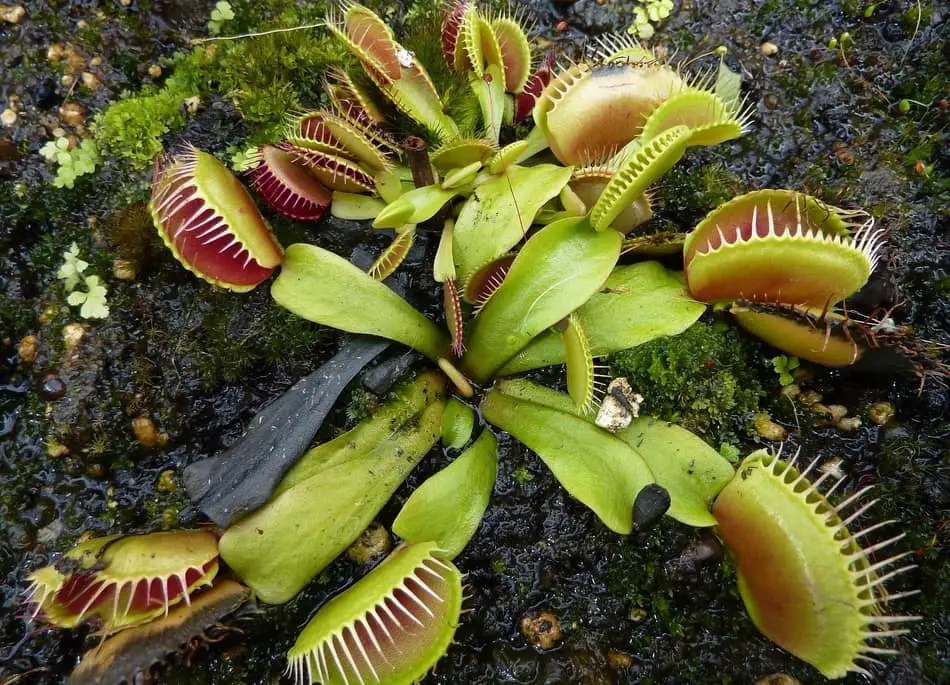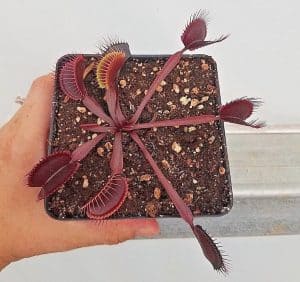Not all Venus flytraps are the same; some have different shapes and colors. When I was building my carnivorous plants’ collection, I did some in-depth research about Venus flytrap color varieties. I will share what I learned in this article.
Venus flytraps commonly exhibit green leaves with burgundy coloring inside the traps. Some Venus flytrap cultivars exhibit different red and green combinations. Cultivars do not grow in the wild, but they can be purchased from nurseries.
In this article, you will learn about the different color varieties of Venus flytraps. Explore all the possibilities before buying a plant.
What Color Are Venus Flytraps?
There is only one species of Venus flytrap or Dionaea Muscipula. And they are only native to a very small region in the United States. They grow naturally in South Carolina and North Carolina.
In the wild, Venus flytraps exhibit bright green and red colors. The leaves are green, and the inside of the traps is red or burgundy. Not all plants exhibit the same brightness in color; the colors can vary depending on the variety.
For example, some of the traps in the photo below exhibit red coloring in the exterior part of the traps.

Besides the standard colors, there are a couple of color varieties. These varieties are not available in the wild. They are cultivars.
What is a cultivar? A cultivar is a cultivated variety of a particular plant (in this case, Venus flytraps). Cultivated Varieties do not grow in the wild; humans develop them.
The following are some interesting color varieties:
- Akai Ryu Red Dragon: All red Venus flytrap
- Dionaea Green Dragon: Red Venus flytrap with green borders in the trap
- Justina Davis: All green Venus flytrap
Red Dragon (Akai Ryu)

Ron Gagliardo developed this cultivar at the Atlanta Botanical Garden. The Akai Ryu is a completely red Venus flytrap. This variety exhibits deep burgundy color in its leaves and inside the traps.
It is normal for this plant to exhibit a few specs of green coloring. An increase in green usually indicates a lack of light exposure.
There is a similar cultivar to the Red Dragon, the Dionaea Red piranha. It is a clone hybrid between the Red Dragon and the Dionaea “Dente.” The clone characterizes by short triangular teeth and burgundy colors.
I wrote a whole article on the Akai Ryu. If you are interested in this unique variety, make sure to read the article with its care and shopping tips.
Dionaea Green Dragon
This variation of Venus flytrap is somehow similar to the Akai Ryu, but the color scheme changes slightly. The Green dragon is almost entirely red. But, the edges of the traps characterize by having a green border next to the cilia.
Dionaea “Justina Davis”
Many Venus flytrap varieties focus on increasing the ratio of red to green colors. The Justina Davis variety is fully green. There is no red.
This variety is fully green. These plants can never gain the red coloring inside the trap. The Justina Davis Venus flytrap is not the only all-green Venus flytrap. For example, the Dionaea “Gremlin” is a fully-green Venus flytrap clone.
Other Venus Flytrap Cultivars
Not all cultivars focus on developing different color combinations or patterns. For example, some Venus flytrap varieties exhibit larger traps. I own a B-52 Giant Venus flytrap. The traps of such variety reach a size of 1.5 inches, which is well over the 1-inch standard.
All cultivars are the same species, but with some slight variation. They do not require any special care, only the standard care considerations.
Where to Buy Venus Flytrap Cultivars?
Standard Venus flytraps are available in a variety of stores. Walmart, Home Depot, and Lowes sell them during the spring and summer. Some specialized nurseries carry Venus flytraps and other carnivorous plants. Also, online stores are a suitable option. Several online stores sell Venus flytraps through Etsy and Amazon.
It is unlikely that you will find unique cultivars in general garden stores. For unique Venus flytrap varieties, consider contacting your local nursery or browsing online. Make sure to specify the cultivar you are looking for and its characteristics.
The list below includes a few shops that sell different varieties of Venus flytrap. Visit their website to check availability and pricing.
- predatoryplants.com
- carnivorousplantnursery.com
- californiacarnivores.com
- petflytrap.com
- flytrapcare.com/store/
Should My Venus Flytrap Be Red?
Not all Venus flytraps have the same colors, but the vast majority exhibit a combination of green and red.
Some cultivars, like the Green Dragon, characterize by completely green Venus flytraps. Those varieties won’t exhibit any red at all.
Most Venus flytraps exhibit green leaves and red inside their traps. Some plants lose red coloring due to a lack of proper lighting. Bright red traps are usually an indication of good health.
A Venus flytrap loses all or most of its red color when it does not have enough access to light, and it is struggling to produce enough nutrients through photosynthesis.
You can encourage the production of bright red leaves by placing your Venus flytrap under bright light. Venus flytraps thrive in sunny areas. Optimally, they should receive 10-12 hours of sunlight. But, they can be healthy with at least 6 hours of sunlight. The light source can be the sun or artificial light.
You can learn more about the lighting requirement here: How do Venus flytraps turn red?. The article guides you through the process of producing healthy traps with bright red colors.
Are There Blue Venus Flytraps?
You might have seen some ads or pictures that show bright blue or purple Venus flytraps. Vendors claim to sell blue Venus flytrap plants and seeds.
Blue Venus flytraps do not exist. A series of scammers offer these false novelty products, but blue Venus flytraps are not real. Only red and green combinations are available.
Do not attempt to buy blue Venus flytraps; they are a scam. I haven’t tried buying them, but people within the community have bought the seeds or the plants. In all cases, the sellers were fake. They sent seeds from other plants and just standard Venus flytrap.
Are Yellow and Black Leaves Normal in Venus Flytraps?
Venus flytraps grow very quickly. They produce new leaves often, as old ones wither.
Black leaves in a Venus flytrap are normal. When a leaf withers, it dries up and turns completely black. Then, the leaf will start to decompose. It can be trimmed off or left there without any health risks.
It is common to observe black leaves in a Venus flytrap. Those leaves are dead, and they serve nor purpose. However, black leaves on their own are not a sign of poor growing conditions. The only time when the owner should get concerned if the plant is suddenly losing leaves a lot faster than it is producing them.
Yellow or brown leaves are also common in Venus flytraps. However, these colors are usually an indication of poor growing conditions. Yellow leaves sometimes occur when employing the incorrect water source. Water with minerals and other nutrients can cause mineral burns and cause yellow leaves. Venus flytraps require nutrient-free mineral-free water, such as:
- Distilled water
- Reverse osmosis water
- Rainwater
A single yellow leaf does not determine the overall health of the plant. But, if multiple ones start to appear, it is time to assess the plant’s health. You can avoid care mistakes by reviewing this Venus Flytrap Care Sheet (you can download it from the article).
Final Thoughts
The different varieties of Venus flytraps allow you to experiment and buy unique plants. It is important to be aware of the colors available, as many online scammers claim to sell Venus flytraps of crazy colors such as blue or purple.
Selecting a Venus flytrap is a fun process. And once you own one, it is time to learn about their care and ensure they remain healthy. Color changes, for example, can indicate poor or optimal growing conditions. I made an article that discusses the meanings of different color changes: Why is My Venus Flytrap Changing Color. It explains all the color changes you might encounter while growing Venus flytraps.


